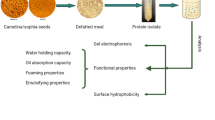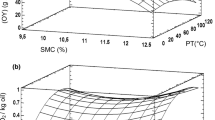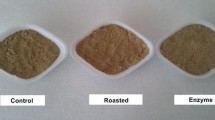Abstract
This investigation determined the effects of oil processing conditions on some functional properties of Cuphea PSR23 seed proteins to evaluate their potential for value-added uses. Flaked Cuphea seeds were cooked at 82°C (180°F) for 30, 75, or 120 min in the seed conditioner and then screw-pressed to extract the oil. Cooked flakes and press cakes were analyzed for proximate composition and protein functional properties. Results were compared with those of unprocessed ground, defatted Cuphea seeds. Protein from unprocessed Cuphea seeds had excellent emulsifying properties, poor foaming properties, poor solubility (10%) at pH 4–7, and much greater solubility at pH 2 and 10 (57 and 88%, respectively). Solubility profiles showed that cooking the flaked seeds to 82°C for 30 min resulted in a 50–60% reduction in soluble proteins. Cooking for 120 min gave <6% soluble proteins at all pH levels. Cooking for 75 min gave good oil yields but also resulted in <10% soluble proteins at pH 2–7 and 25% soluble proteins at pH 10. Seed cooking and screw pressing during oil extraction had significant detrimental effects on the solubility of Cuphea seed protein but generally improved its foaming capacity and emulsifying activity.
Similar content being viewed by others
References
Wolf, R.B., S.A. Graham, and R. Kleiman, Fatty Acid Composition of Cuphea Seed Oils, J. Am. Oil Chem. Soc. 60:27–28 (1983).
Thompson, A.E., and R. Kleiman, Effect of Seed Maturity on Seed Oil, Fatty Acid and Crude Protein Content of Eight Cuphea Species, —Ibid. 65:139–146 (1988).
Isbell, T.A., and R.W. Behle, Progress in the Development of Cuphea as a Crop for Midwest Growers, Inform 14:513–515 (2003).
Knapp, S.J., Breakthroughs Towards the Domestication of Cuphea, in: New Crops, edited by J. Janick and J.E. Simon, John Wiley & Sons, New York, 1993, pp. 372–379.
Nikokyris, P.N., and K. Kandylis, Feed Protein Fractions in Various Solvents of Ruminant Feedstuffs, J. Sci. Food Agric. 75:198–204 (1997).
Cermak, S.C., T.A. Isbell, J.E. Isbell, G.G. Akerman, B.A. Lowery, and A.B. Deppe, Batch Drying of Cuphea Seeds, Ind. Crops Prod. 21:353–359 (2005).
American Oil Chemists' Society, Official Methods and Recommended Practices of the AOCS, 5th edn., AOCS Press, Champaign, 1997.
Wu, Y.V., and M.P. Hojilla-Evangelista, Lesquerella fendleri Protein Fractionation and Characterization, J. Am. Oil Chem. Soc. 82:53–56 (2005).
Balmaceda, E.A., M.K. Kim, R. Franzen, B. Mardones, and J.C. Lugay, Protein Functionality Methodology—Standard Tests, in Food Protein Chemistry, J.M. Regenstein and C.E. Regenstein (eds.), Academic Press, New York, 1984, pp. 278–291.
Myers, D.J., M.P. Hojilla-Evangelista, and L.A. Johnson, Functional Properties of Protein Extracted from Flaked, Defatted, Whole Corn by Ethanol/Alkali During Sequential Extraction Processing, J. Am. Oil Chem. Soc. 71:1201–1204 (1994).
Wu, W.U., N.S. Hettiarachchy, and M. Qi, Hydrophobicity, Solubility, and Emulsifying Properties of Soy Protein Peptides Prepared by Papain Modification and Ultrafiltration, —Ibid. 75:845–850 (1998).
Evangelista, R.L., and L.K. Manthey, Protein and Oil Contents and Fatty Acid Composition of Cuphea PSR-23 Seeds, Abstract No. 410, American Chemical Society 36th Annual Great Lakes Regional Meeting Program and Abstracts, 2004, p. 188.
Wolf, W.J., Soybeans and Other Oilseeds, in Kirk-Othmer Encyclopedia of Chemical Technology, 3rd edn. (ed.), John Wiley & Sons, New York, 1983, Vol. 21, pp. 417–442.
Cheftel, J.C., J.L. Cuq, and D. Lorient, Amino Acids, Peptides, and Proteins, in Food Chemistry, 2nd edn., edited by O.R. Fennema, Marcel Dekker, New York, 1985, pp. 274–275, 282–310, 349–355.
Hojilla-Evangelista, M.P., and L.B. Dunn, Jr., Foaming Properties of Soybean Protein-based Plywood Adhesives, J. Am. Oil Chem. Soc. 78:567–572 (2001).
Kinsella, J.E.. Functional Properties of Proteins in Foods: A Survey, Crit. Rev. Food Sci. Nutr. 7:219–280 (1976).
Phillips, L.G., D.M. Whitehead, and J. Kinsella, Protein-Stabilized Foams, Emulsions, Structure-Function Properties of Food Proteins, Academic Press, San Diego, 1994, pp. 131–169.
Heywood, A.A., D.J. Myers, T.B. Bailey, and L.A. Johnson, Functional Properties of Low-fat Soy Flour Produced by an Extrusion-Expelling System, J. Am. Oil Chem. Soc. 79:1249–1253 (2002).
Hojilla-Evangelista, M.P., D.J. Sessa, and A. Mohamed, Functional Properties of Soybean and Lupin Protein Concentrates Produced by Ultrafiltration-Diafiltration, —Ibid. 81:1153–1157 (2004).
Author information
Authors and Affiliations
Corresponding author
About this article
Cite this article
Hojilla-Evangelista, M.P., Evangelista, R.L. Effects of cooking and screw-pressing on functional properties of Cuphea PSR23 seed proteins. J Amer Oil Chem Soc 83, 713–718 (2006). https://doi.org/10.1007/s11746-006-5028-8
Received:
Accepted:
Issue Date:
DOI: https://doi.org/10.1007/s11746-006-5028-8




